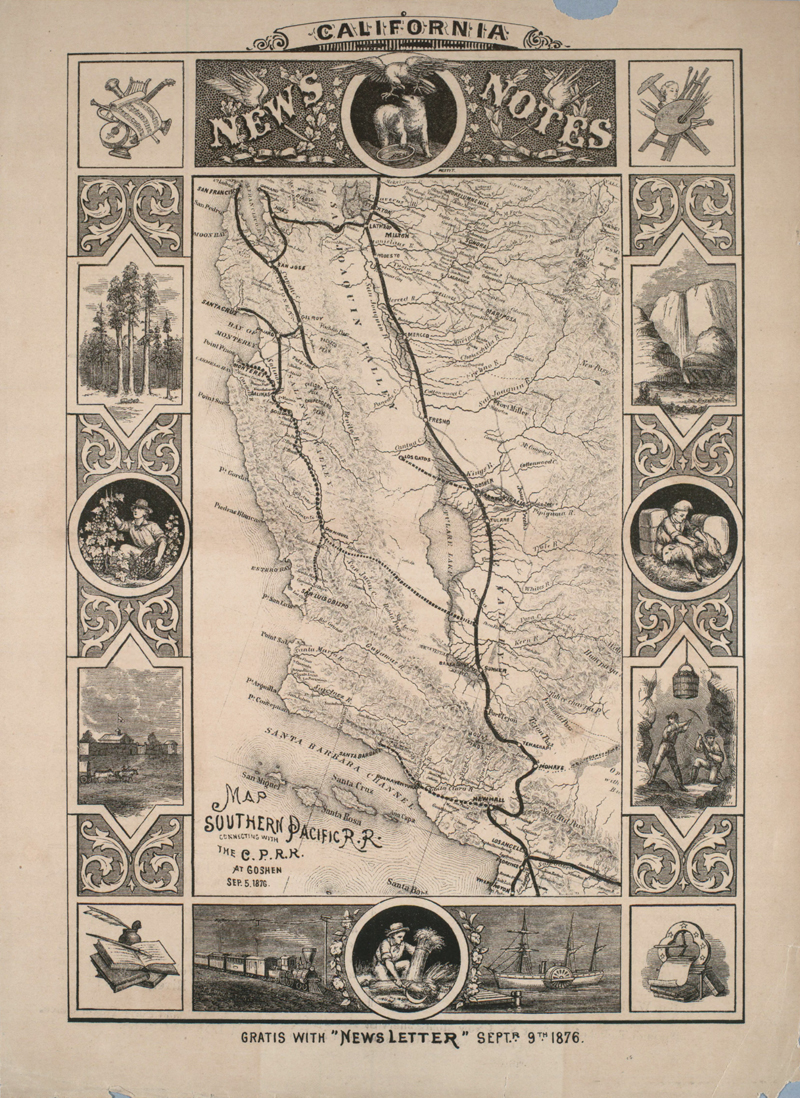|
|
Map Published 9-9-1876

Click image to enlarge or [Jumbo Size] Map: "Southern Pacific R.R. connecting with the C.P.R.R at Goshen, Sept. 5, 1876." Engraving on paper, 30.6cm x 22.2cm, by T.J. Pettit & Co. (1870-1880s) of San Francisco. Published as part of an unidentified newsletter on Sept. 9, 1876, four days after the Southern Pacific and the Central Pacific came together. On the back — which we have not seen — is the official timetable of the Southern Pacific Railroad between San Francisco and Los Angeles. Goshen, in Tulare County west of Visalia, is the place where one railroad company's track ended and the other's started (more or less; see below). It is not where the rails physically came together on Sept. 5, 1876. That happened in a big ceremony in which S.P. President Charles Crocker hammered in a golden spike near Lang Station in present-day Canyon Country. Shearer's "The Pacific Tourist" (1884:336) says this about Goshen: Goshen, 229.1 miles [from San Francisco], is where the Southern Pacific Railroad connects with the Visalia branch of the Central. The northern terminus of this part of the Southern Pacific is not at Goshen but at Huron, 40 miles west of Goshen. These 40 miles are the Goshen Division of the Southern Pacific. Per Shearer, the Goshen division included Hanford, Lemoore, Heinlen and Huron. Cont.: At Goshen there is another branch railroad to Visalia. It is only seven miles long, and was built by the people of Visalia, the principal and county town of Tulare County. This Visalia Railroad is wholly independent of the Central and Southern Pacific roads.... Soon after leaving Goshen, there is a tangent to Lerdo — 50 miles — the longest piece of straight track on the road. The map image is from the Robert B. Honeyman Jr. Collection of Early Californian and Western American Pictorial Material in the Bancroft Library at the University of California, Berkeley. About the collector: Robert Brodhead Honeyman graduated in 1920 from Lehigh University, Penn., with an engineering degree. Honeyman was an avid collector throughout his lifetime. He collected in a variety of areas including art, science, American and English literature, stamps, British orders, decorations, medals and others. His collection of books and manuscripts in the history of science was quite significant and was later auctioned at Sotheby's. Honeyman maintained two homes, one in Rye, N.Y., and the other in Southern California near Mission San Juan Capistrano where he built his private museum at Rancho Los Cerritos. He died in 1987 at 90 years of age. —Bancroft Library
LW2726: 19200 dpi jpeg from digital image of item in Bancroft Library, Catalog No. BANC PIC 1963.002:1822-A. |
The site owner makes no assertions as to ownership of any original copyrights to digitized images. However, these images are intended for Personal or Research use only. Any other kind of use, including but not limited to commercial or scholarly publication in any medium or format, public exhibition, or use online or in a web site, may be subject to additional restrictions including but not limited to the copyrights held by parties other than the site owner. USERS ARE SOLELY RESPONSIBLE for determining the existence of such rights and for obtaining any permissions and/or paying associated fees necessary for the proposed use.
